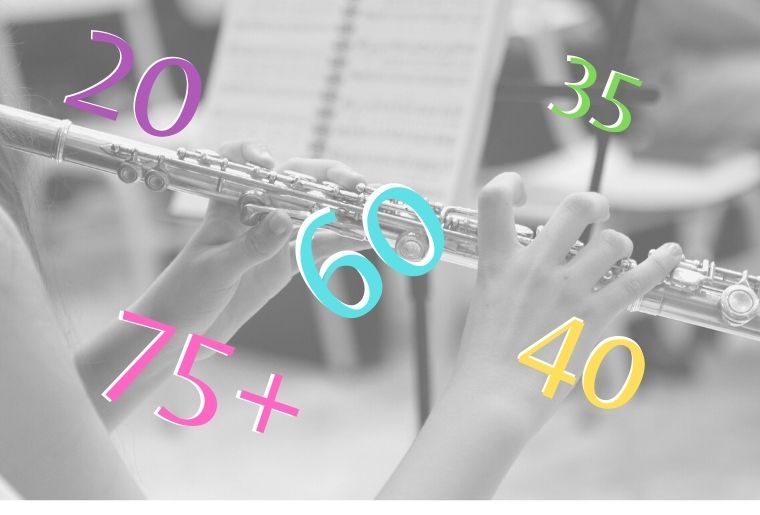A lot of people are concerned about taking up the flute later in life. This can be for many reasons, they think they are too old to learn the flute, they may lack confidence, or think they don’t have the ability. The flute is considered an instrument that takes time and practice.
It’s never too late to learn to play the flute. As an adult you can learn to play the flute at any age; whether that be in your 20 and 30s or 40+ or even in your 70s+.
Whether you have learned the flute before and want to return or this is a new direction for you there is no reason you cannot take up the flute at any age. There are many advantages to playing the flute later in life. The only exceptions that I can see are if you have something physical that can stop you and even then there are usually ways around it as discussed below.

What Age Is Too Old To Learn The Flute?
It’s never too late to learn the flute. You can learn the flute at any age.
I started from scratch again in my fifties having forgotten everything. Seriously, I could barely get a squeak out of it when I started! I regret all those lost years.
While researching what books to use to learn from I read the Amazon comments and some people on there started learning to play in their 70s.
Learning to play a musical instrument engages the whole brain so it’s a good brain workout that can help combat dementia later in life. It also keeps your fingers nimble. And can be a talking point to share with friends.
I’ve also seen people ask if its too late to learn the flute in their 20s!
There is absolutely no reason why you can’t learn to play the flute. You are still very young and if you decide it’s for you you could have 60-70 years to enjoy playing your music. Go for it!
You don’t have to go full time and can learn from home either self taught or with a teacher online or off.
If you are in your 20s and want to learn the flute to become a professional it’s still possible. Yes, you are behind other flute players that started at age 10 but that shouldn’t stop you. It can take about 5-10 years depending on your route and end goal. This is still very young and there are so many different options that it’s worth going for your dream. You won’t know until you try.
Older adults have more fun with their instruments. There’s a different mindset when you take up an instrument at school, to that you have later in life.
I know my own attitude to playing has changed completely from when I was younger. There’s a lot less pressure for one; both from myself and those around me. Coming at something from an attitude of fun and enjoyment without the weight of exams makes a huge difference.
There’s no reason to take an exam if you want to check your progress, but the whole emphasis is different. The irony is you are more likely to enjoy playing and therefore more likely to do it and progress faster.
There are some obstacles older players can have that you most likely wouldn’t have encountered as a child.

The Advantages of Later-Life Flute Learning
It can be easier to learn the flute as an adult than as a child because you have many advantages over the child.
- You are full-grown which makes playing easier for most people. You probably don’t need to have a bent head for your flute.
- Adults are likely to be more committed than most children. They are often (but not always) more self-disciplined and will make the effort.
- You already have many life experiences that you can draw from to help you learn. Whether that be self-discipline, previous knowledge of music.
- It’s something you want to do rather than something your parents want you to do.
- If you are older you may have the experience that helps you learn faster or in a better more focused way.
- Better cognaitve skills.
- Less likely to develop dementia.
- Better hand mobility.
Drawbacks To Learning The Flute Later In Life
- Adults often have time constraints and commitments that children don’t have. If you have a full-time job, a family, etc, playing the flute will need to be fitted in. The temptation is to not play because…. this is a mistake and leads to lack of progress then finally giving up.
- Children are often more readily accepting that they can do things whereas adults often come from a place of “not sure about that.”
- You may have injuries or illnesses that need to be considered. Except in extreme circumstances, this shouldn’t stop you and even then there are alternatives like the magic flute
- Actually, this one is at any time in life. Playing for long periods of time can cause hearing issues.
Regardless of whether you decide to become self-taught or go with a teacher, it’s possible to learn the flute for most people.
How Long Does It Take You To Learn The Flute?
It can take as little as a year up to 10 years to learn to play the flute. How long it takes depends on your goals and how much time, effort, and practice you put in, and how consistently and effectively you practice.
Learning to play the flute is a continual process that never ends while you play. It doesn’t matter if you start to learn at 10, 20, 30, or even 60 years old. The process is similar. The time frames may vary.
It’s a good idea to set a goal and to define what you consider as having learned the flute. That can be different for everyone. Next, what your aims are in learning?
Do you want to try something new? If that’s all then a few weeks will be enough.
Or do you want to play just for yourself or family and friends? You could be turning out simple tunes in as little as a month. Six months to reasonable more complex tunes.
Do you want to play in a local band/orchestra as an amateur? (Note: this choice also affects how you might choose to learn). I’d estimate a couple of years at least.
How long you dedicate each day and how well you practice will also determine how long your goal takes.
Why Not Make A More Personal Goal For Flute Playing?

Perhaps you have another personal goal. My sister recently took up the clarinet. She had always wanted to try it.
Her goal was simply that – to try it. She rented her instrument for 3 months and learned the basics. Then decided it wasn’t for her. For her this was a win, she had removed this goal from her not done regret list.
But more importantly, she found that she wanted to do something more than her old hobbies. This led her to the ocarina, which she had never considered because she didn’t know it existed.
- Stage one, learn the basics
- Stage two learn the chromatic scale
- Stage 3 fine-tune learning until notes flow naturally.
- Find some flight of the bumblebee sheet music and practice.
Mine is to play flight of the bumblebee by Nikolai Rimsky-Korsakov. I saw it on the recorder channel on a recorder and decided that was my goal. To play this music you have to be able to play the chromatic scale accurately, without thinking, and very fast about 184 beets per minute speeds. although I’d be happy to play it more slowly than that.
So I set my goals. What are yours?
You are supposed to put a time frame on goals it’s that SMART goal thing that everyone talks about. That’s not for everyone. That’s the joy of learning later in life we don’t have to do the exams, there is no pressure or schedule, we decide our own path. Of course, that can also be a downfall as well.
Its up to us!
Challenges Of Playing For Older or Injured Flute Players
There may be things that can hinder you as you get older. For instance due to a shoulder injury and back trouble I couldn’t hold the flute up long enough to practice breathing let alone get a tune. At one point I thought I might have wasted my money and would have to stop playing.
The flute is a very odd angle to play at and requires a stretch of the arms while holding them up high. This can be a challenge for some people.
How To Make Your Flute Easier To Play
There are a few things you can do to change the angle that you play the flute to make it easier to play.
- If you have difficulty stretching you could get a flute with a curved head joint. This is designed for smaller people, children, and those that do not want to stretch. In some places these come in the flute pack anyway, you need to check though.
- The other option would be to get a flute head joint that allows you to play the flute like a recorder. These are designed to turn the flute into a whistle, you don’t have to have difficulties playing the flute to use them. However, if you are having issues playing the flute this way can help.
- A 30-degree head joint that allows you to play your flute from the side but lowers the angle of the flute to make it easier to play.
- A swan neck head joint lets you play with the flute in front of you.
- You can also custom adapt instruments.
Unfortunately, some of these options are quite expensive as head joints can be pricy, so they are not suitable for those on a budget. It may be possible to get a 2nd hand one. But all the ones I have seen are between 3-6 times what I paid for my flute!
If you think you will have difficulty with the weight of your flute you can get quality plastic flutes that are lighter to hold.
I found this YouTube Video. It explores different options for flute types and heads. I thought it would go well with this post.
There are lots of different flutes to choose from. So, if the traditional silver, side flute isn’t an option there are others that are easier to hold.
There are many different types of flute that you can try.

Some examples of different types of flutes:
- The Recorder (if the noise of the soprano irritates you, get an Alto or Tennor instead – so much better)
- Ocarina (a globular flute) Just the most amazing sound. You do have to hold your hands high. It’s such a fun instrument.
- Japanese bamboo flute – These are just beautiful.
- Native American flute – Hauntingly beautiful.
The other challenge depends on how fit and healthy you are. You need to be able to hold a reasonable amount of air in your lungs to play the flute and let small amounts out gradually.
While a great deal of that is the technique, proper breathing, and practice, all of which can be taught, some people may have conditions that hinder their playing ability. My mum with a respiratory condition and unable to lift her arms just couldn’t do it. She’s the same age as the person that was learning at 75.
A good way to try the flute so see if you like it is to rent it. These gives you time to explore your instrument without the expense of paying out for it if you don’t want to. This is a great way into flute playing.
